Charles E W Bean, Diaries, AWM38 3DRL 606/270 PART 1/1 - 1918 - 1939 - Part 8


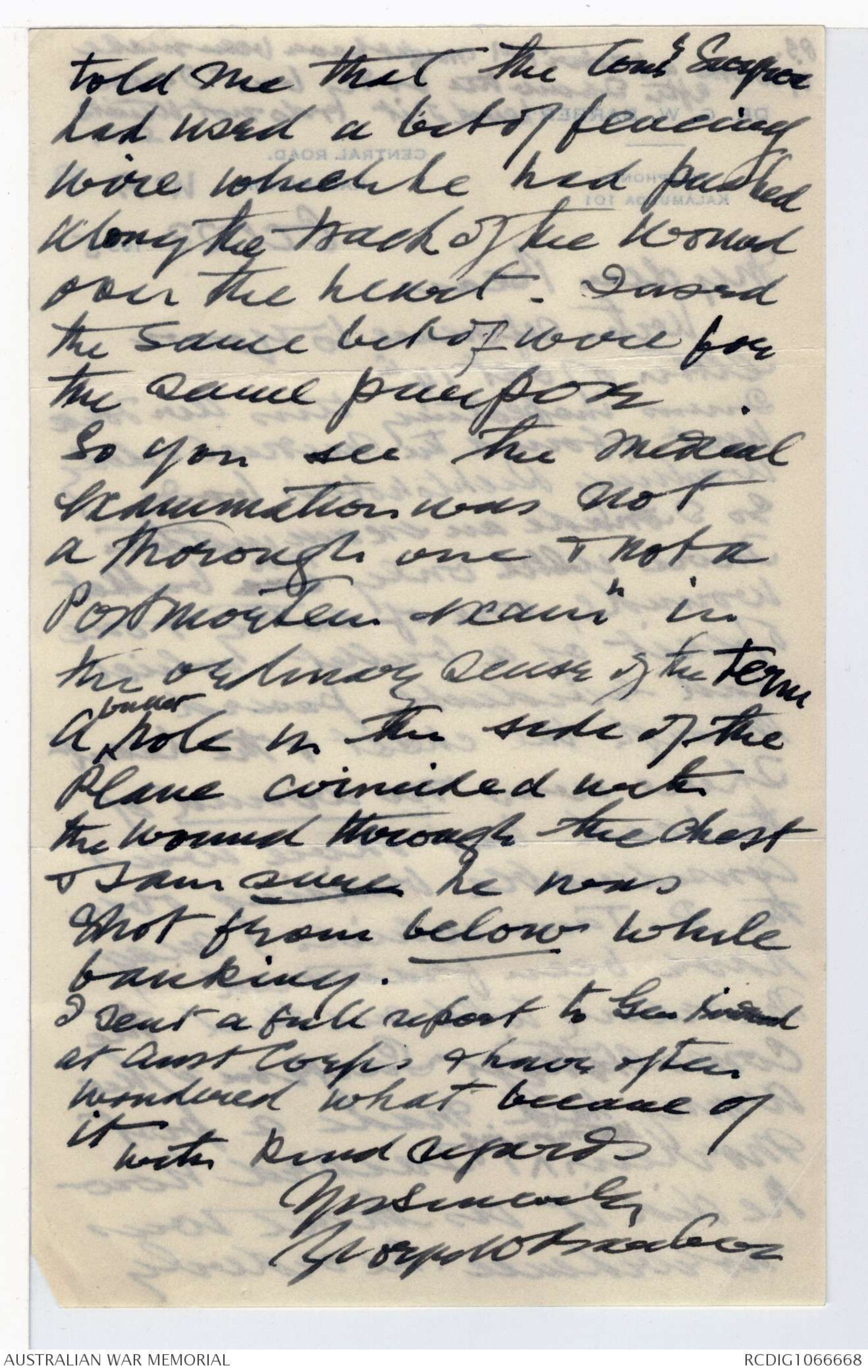

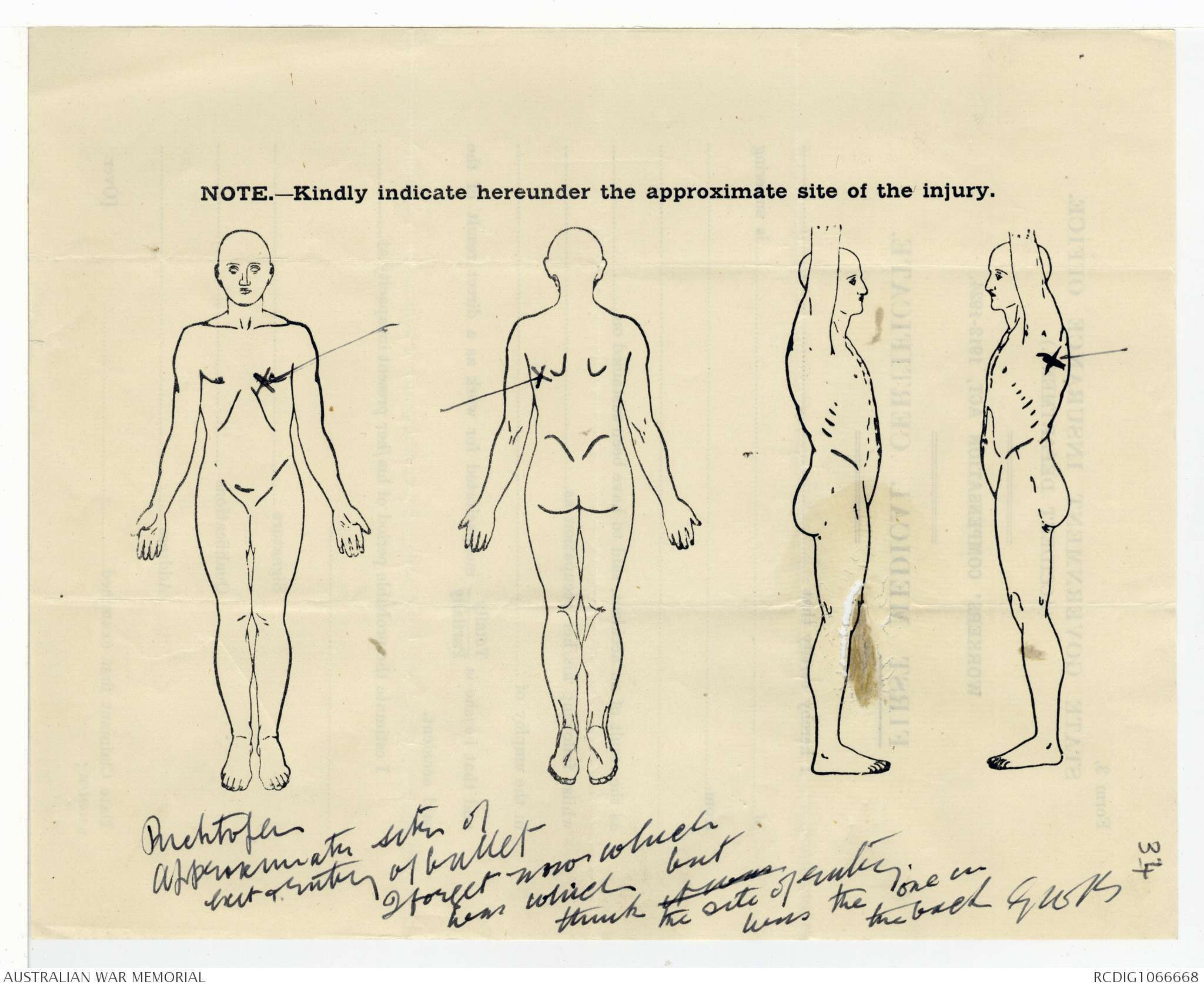
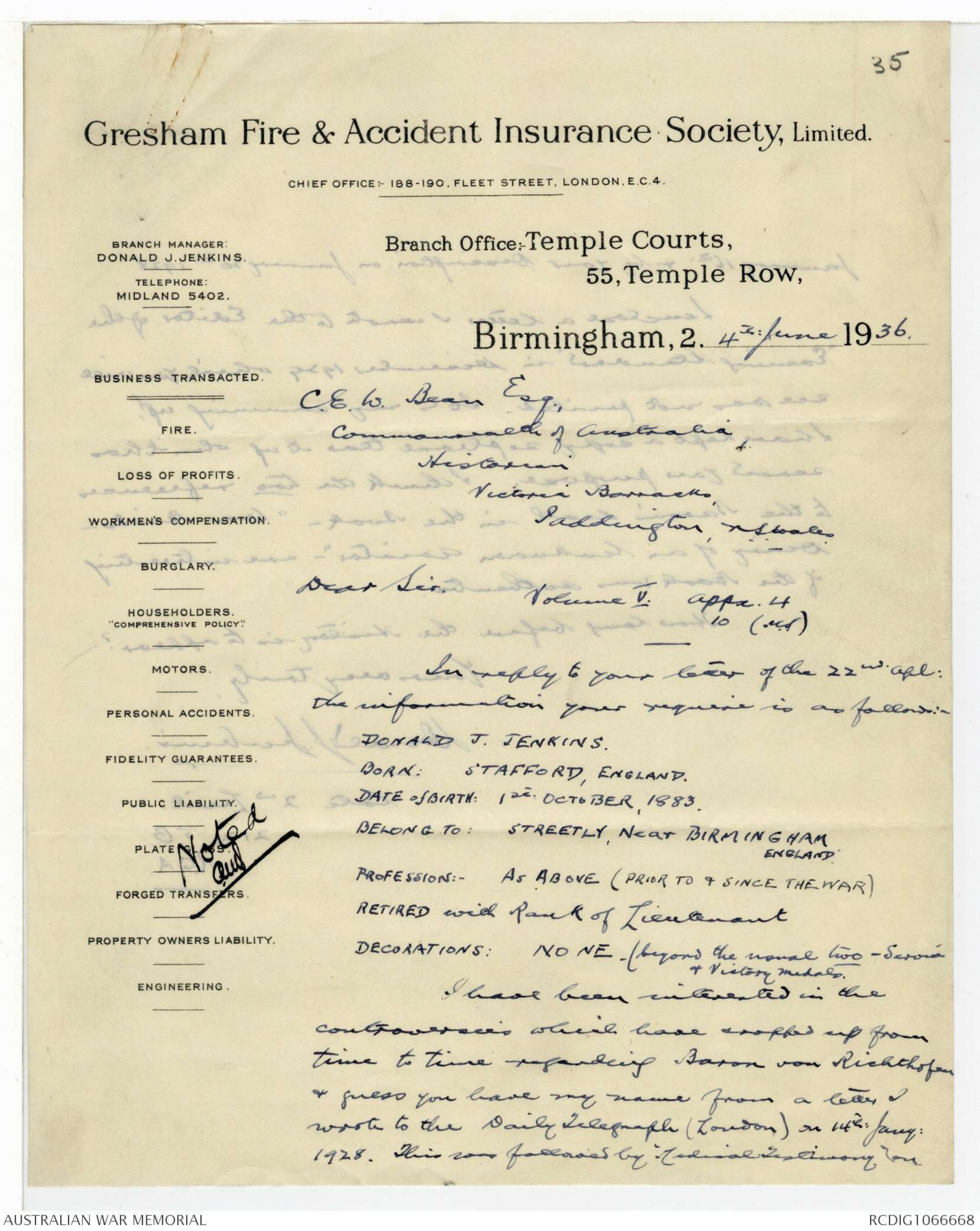


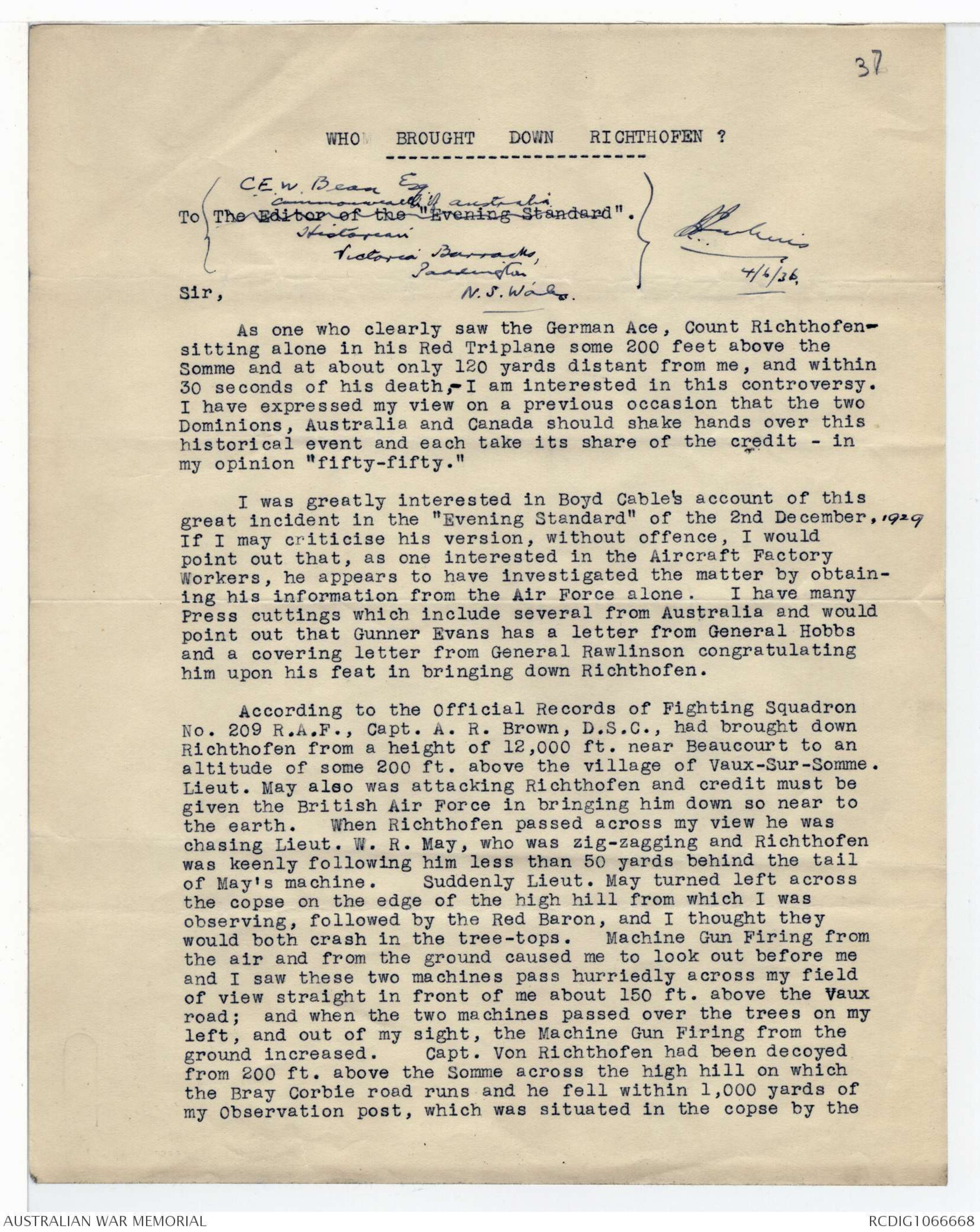
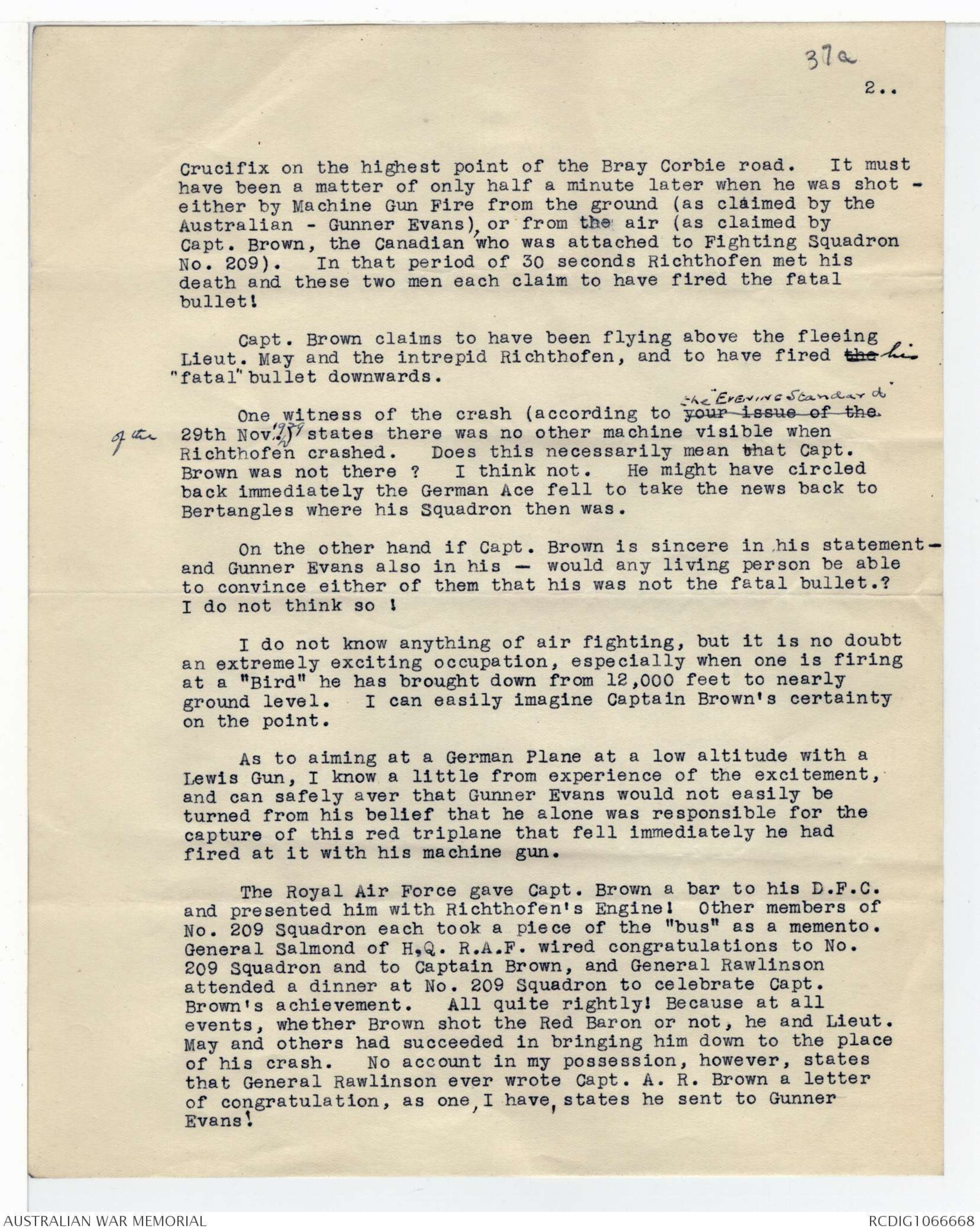
31
Hand drawn diagram - see original document.
[*I am not
clear now which
side he curled at the
last bit the way &
have shown on the opposite side*]
P.S.
Of course a proper PM might have been made
after I saw the body but I never
heard of it & do not think
so.
DR. G. W. BARBER
CENTRAL ROAD.
KALAMUNDA. WA 32
TELEPHONE:
KALAMUNDA 101
Oct 23 1935
My dear Bean
With reference to your
letter of Oct 14th
I was inspecting this Air Force
Unit & found the medical orderly
washing Richtohofen's body
so I made an examination
There were only one two bullet
wounds, one of entry & one
of exit of a bullet which
had evidently passed
through the chest & the heart
There was no wound of
the head but there was
considerable bruising over
the R. Jaw which may
have been fractured
The orderly told me that the
Consulting Surgeon of the
Army had made a post
mortem ^that morning & I asked how
he did it as there was
no evidence. The orderly
told me that the Consg Surgeon
had used a bit of fencing
wire which he had pushed
along the track of the wound
& over the heart. I used
the same bit of wire for
the same purpose
So you see the medical
examination was not
a thorough one & not a
Post Mortem examn in
the ordinary sense of the term
a ^bullet hole in the side of the
plane coincided with
the wound through the chest
& I am sure he was
shot from below while
banking.
I sent a full report to Gen Birdwood
at Aust Corps & have often
wondered what became of
it
with kind regards
Yrs sincerely
George W Barber
33
Central Rd
Kalamunda
Dec 22nd 1934
[*CEW Bean
This is a letter
I wrote but decided
not to send
as I hate these
paper controversies
GWB*]
The Editor
The Daily News
Perth
Dear Sir
With reference to your
Article " How Richthofen died"
of todays date.
General Monash was in
error when stating that
Richtohofen was shot through
the head.
There were only two wounds
one of entry & one of exit
of a bullet which had
evidently passed through the
heart.
I made an examination of the
body & furnished a report to
the Australian Corps Commander
I am
Yrs faithfully
George W Barber
NOTE.-Kindly indicate hereunder the approximate site of the injury.
Diagram - see original document.
Richtofen
Approximate site of
exit & entry of bullet
I forget now which
was which but
think it was
the site of entry
was the one in
the back
GWB
34
35
Gresham Fire & Accident Insurance Society, Limited.
CHIEF OFFICE:- 188-190 FLEET STREET, LONDON, E.C.4.
Branch Office: Temple Courts,
55, Temple Row,
Birmingham, 2. 4th June 1936.
BRANCH MANAGER:
DONALD J. JENKINS.
TELEPHONE:
MIDLAND 5402.
BUSINESS TRANSACTED.
FIRE.
LOSS OF PROFITS.
WORKMEN'S COMPENSATION.
BURGLARY.
HOUSEHOLDERS
"COMPREHENSIVE POLICY".
MOTORS.
PERSONAL ACCIDENTS.
FIDELITY GUARANTEES.
PUBLIC LIABILITY.
PLATE GLASS.
FORGED TRANSFERS.
PROPERTY OWNERS LIABILITY.
ENGINEERING.
C.E.W. Bean Esq.,
Commonwealth of Australia
Historian
Victoria Barracks,
Paddington, N.S.Wales.
Dear Sir.
Volume V. Appx. 4
10 (M.S.)
In reply to your letter of the 22nd. Apl:
the information your require is as follows:-
DONALD J. JENKINS.
BORN: STAFFORD, ENGLAND.
DATE OF BIRTH: 1st. OCTOBER, 1883.
BELONG TO: STREETLY, Near BIRMINGHAM
ENGLAND.
PROFESSION:- As ABOVE (PRIOR TO & SINCE THE WAR)
RETIRED with Rank of Lieutenant
DECORATIONS: NONE. (beyond the usual two - Service
& Victory medals.
I have been interested in the
controversies which have cropped up from
time to time regarding Baron von Richthofen
& guess you have my name from a letter I
wrote to the Daily Telegraph (London) on 14thJany:
1928. This was followed by: Medical Testimony on
[*Noted
C.ewB*]]
January 16th: & by your Description on January 20th: 1928.
I enclose a letter I wrote to the Editor of the
"Evening Standard" in December 1929 which you will
see was not printed. It is my summing up!
I have kept a copy so please tear it up when it has
served your purpose. I think the two references
to the Baron's death in the book - "War Birds -
Diary of an Unknown Aviator" - are interesting
if the book was authentic.
How long before the History is to appear?
Yours very truly,
Donald J. Jenkins.
late 2nd Lieut:
212, S.B
R.G.A.
36
Evening Standard
(EVENING STANDARD CO.LTD.)
47, SHOE LANE,
LONDON, E.C.4.
PHONE: CITY 2040 (PRIVATE EXCHANGE)
TELEGRAPHS: "EVENING STANDARD, LONDON."
ALL COMMUNICATIONS TO BE ADDRESSED TO
THE COMPANY.
In your reply please refer to
5th December 1929
D.J. Jenkins Esq.
Dear Sir,
The Editor desires me to thank you
for your letter with reference to Richtofen which he
has read with interest. He regrets, however, that
we are unable to devote further space to the
controversy which has already received very considerable
attention.
Yours faithfully,
[[M.Scott Johnston]]
EDITOR'S SECRETARY.
37
WHO BROUGHT DOWN RICHTHOFEN ?
C.E.W Bean Esq.
Commonwealth of Australia.
To { The Editor of the "Evening Standard".
Historian
Victoria Barracks,
Paddington,
N.S.Wales.
[[D.J. Jenkins]]
4/6/36.
Sir,
As one who clearly saw the German Ace , Count Richthofen -
sitting alone in his Red Triplane some 200 feet above the
Somme and at about only 120 yards distant from me, and within
30 seconds of his death,-I am interested in this controversy.
I have expressed my view on a previous occasion that the two
Dominions, Australia and Canada should shake hands over this
historical event and each take its share of the credit - in
my opinion "fifty-fifty."
I was greatly interested in Boyd Cable's account of this
great incident in the "Evening Standard" of the 2nd December, 1929
If I may criticise his version, without offence , I would
point out that, as one interested in the Aircraft Factory
Workers, he appears to have investigated the matter by
obtaining his information from the Air Force alone. I have many
Press cuttings which include several from Australia and would
point out that Gunner Evans has a letter from General Hobbs
and a covering letter from General Rawlinson congratulating
him upon his feat in bringing down Richthofen.
According to the Official Records of Fighting Squadron
No. 209 R.A.F., Capt. A. R. Brown, D.S.C., had brought down
Richthofen from a height of 12,000 ft. near Beaucourt to an
altitude of some 200 ft. above the village of Vaux-Sur-Somme.
Lieut. May also was attacking Richthofen and credit must be
given the British Air Force in bringing him down so near to
the earth. When Richthofen passed across my view he was
chasing Lieut. W. R. May, who was zig-zagging and Richthofen
was keenly following him less than 50 yards behind the tail
of May's machine. Suddenly Lieut, May turned left across
the copse of the edge of the high hill from which I was
observing, followed by the Red Baron, and I thought they
would both crash in the tree-tops. Machine Gun Firing from
the air and from the ground caused me to look out before me
and I saw these two machines pass hurriedly across my field
of view straight in front of me about 150 ft. above the Vaux
road; and when the two machines passed over the trees on my
left, and out of my sight, the Machine Gun Firing from the
ground increased. Capt. Von Richthofen had been decoyed
from 200 ft. above the Somme across the high hill on which
the Bray Corbie road runs and he fell within 1 ,000 yards of
my Observation post, which was situated in the copse by the
37a
2..
Crucifix on the highest point of the Bray Corbie road. It must
have been a matter of only half a minute later when he was shot -
either by Machine Gun Fire from the ground (as claimed by the
Australian - Gunner Evans), or from the air (as claimed by
Capt. Brown, the Canadian who was attached to Fighting Squadron
No. 209). In that period of 30 seconds Richthofen met his
death and these two men each claim to have fired the fatal
bullet!
Capt. Brown claims to have been flying above the fleeing
Lieut. May and the intrepid Richthofen, and to have fired the his
"fatal" bullet downwards.
One witness of the crash (according to your issue of the the "Evening Standard"
of the 29th Nov. 1939) states there was no other machine visible when
Richthofen crashed. Does this necessarily mean that Capt.
Brown was not there ? I think not. He might have circled
back immediately the German Ace fell to take the news back to
Bertangles where his Squadron then was.
On the other hand if Capt. Brown is sincere in his statement -
and Gunner Evans also in his - would any living person be able
to convince either of them that his was not the fatal bullet.?
I do not think so !
I do not know anything of air fighting, but it is no doubt
an extremely exciting occupation, especially when one is firing
at a "Bird" he has brought down from 12,000 feet to nearly
ground level. I can easily imagine Captain Brown's certainty
on the point.
As to aiming at a German Plane at a low altitude with a
Lewis Gun, I know a little from experience of the excitement,
and can safely aver that Gunner Evans would not easily be
turned from his belief that he alone was responsible for the
capture of this red triplane that fell immediately he had
fired at it with his machine gun.
The Royal Air Force gave Capt. Brown a bar to his D.F.C.
and presented him with Richthofen's Engine! Other members of
No. 209 Squadron each took a piece of the "bus" as a memento.
General Salmond of H,Q. R.A.F. wired congratulations to No.
209 Squadron and to Captain Brown, and General Rawlinson
attended a dinner at No. 209 Squadron to celebrate Capt.
Brown's achievement. All quite rightly! Because at all
events, whether Brown shot the Red Baron or not, he and Lieut.
May and others had succeeded in bringing him down to the place
of his crash. No account in my possession, however, states
that General Rawlinson ever wrote Capt. A. R. Brown a letter
of congratulation, as one, I have, states he sent to Gunner
Evans!
 Sam scott
Sam scottThis transcription item is now locked to you for editing. To release the lock either Save your changes or Cancel.
This lock will be automatically released after 60 minutes of inactivity.